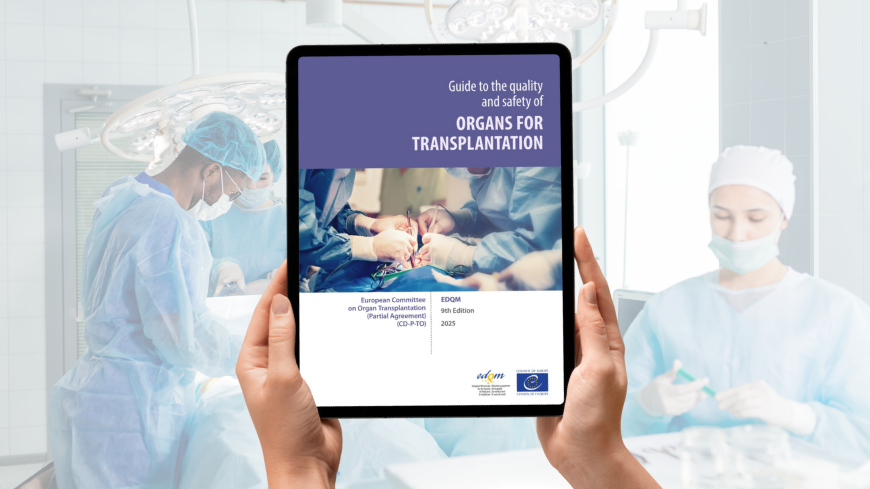Guide to the quality and safety of organs for transplantation
The Guide to the quality and safety of organs for transplantation (Organ Guide) is a key resource published by the EDQM for healthcare professionals working in organ donation and transplantation. It is part of the EDQM’s ongoing strategic efforts to address current and emerging public health challenges and priorities for the benefit of patients, donors and their families.
Progress in organ transplantation in recent decades has been considerable, significantly enhancing patient outcomes and quality of life. The persistent shortage of transplantable organs remains a major obstacle, however, preventing the full realisation of these advancements. In this context, the safety and quality of organs, as for other substances of human origin (SoHO), is fundamental to improving transplantation outcomes and reducing the risk of disease transmission or waste. The Organ Guide addresses these critical challenges, providing the most up-to-date technical guidance based on recent scientific advances in the field.
Now in its 9th edition, the Organ Guide has been supporting healthcare professionals since 2002, with the ultimate goal of improving safe organ transplantation rates. Drafted and updated by a dedicated working party and published under the authority of the European Committee on Organ Transplantation (CD-P-TO), this guide is designed for professionals involved in donor identification, as well as co-ordinators managing living or deceased donation pathways, those responsible for the allocation and clinical use of human organs, quality managers and health authorities responsible for donation and transplantation programmes.
Download the information leaflet for more details on the 9th Edition of the Organ Guide.
Download the electronic version of the Organ Guide from FreePub, the EDQM’s free publications platform.
Purchase the English or French print versions from the EDQM Store.
What has changed in the 9th edition?
All chapters have been thoroughly revised according to the state of the art. Major updates concern Chapters 11 (Organ procurement, preservation and transportation) and 12 (Donation after the determination of death by circulatory criteria (DCD)), and two important new chapters have been added on Principles and good practice in allocating organs from deceased donors (Chapter 17) and Crisis management and contingency planning (Chapter 21). In addition, “Take note!” boxes have been added to summarise and emphasise key extracts, and an updated research agenda section can be found at the end of most chapters, helping readers to identify priority research areas for which evidence is insufficient or non-existent.
A brief summary of the 9th edition of the Organ Guide is described below:
- Chapter 1 provides an overview of the scope and purpose of the guide, along with details on updated content.
- Chapter 2 identifies key steps in the deceased donation process and addresses challenging practices and end-of-life care.
- Chapter 3 outlines the tests required to determine death by neurological and circulatory criteria.
- Chapter 4 covers legal frameworks for obtaining consent and best practices for supporting families of donors.
- Chapter 5 provides detailed guidance on managing potential donors after death is determined by neurological criteria.
- Chapter 6 presents general donor characterisation, assessment and selection criteria, with a donation process flowchart.
- Chapter 7 offers specific guidelines for organ characterisation, assessment and selection criteria.
- Chapter 8 contains updated recommendations to prevent the transmission of infectious diseases, including emerging pathogens, with screening algorithms.
- Chapter 9 provides guidance on assessing the risk of transmission of cancer from donors who may have a history of malignancy.
- Chapter 10 recommends how to handle organs from donors either with conditions such as inherited or autoimmune diseases or who are themselves organ transplant recipients.
- Chapter 11 outlines organ procurement, preservation techniques and transportation procedures.
- Chapter 12 discusses best practice for controlled and uncontrolled donation after circulatory death (DCD).
- Chapter 13 focuses on living donation for kidneys, the liver, lungs and other organs, including psychosocial aspects.
- Chapter 14 covers paediatric organ donation and related outcomes.
- Chapter 15 explores the donation of vascularised composite allografts to improve patient quality of life.
- Chapter 16 highlights biovigilance as a tool for identifying and managing transplantation-related severe adverse reactions and events.
- Chapter 17 introduces principles and good practice in allocating organs from deceased donors, ensuring justice, equity, legitimacy and transparency.
- Chapter 18 discusses how to measure quality in organ donation, procurement and transplantation.
- Chapter 19 reviews factors for assessing transplantation outcomes.
- Chapter 20 provides guidance on communicating risk and promoting shared decision making in solid organ transplantation.
- Chapter 21 offers strategies for crisis management and contingency planning in the transplantation process.





